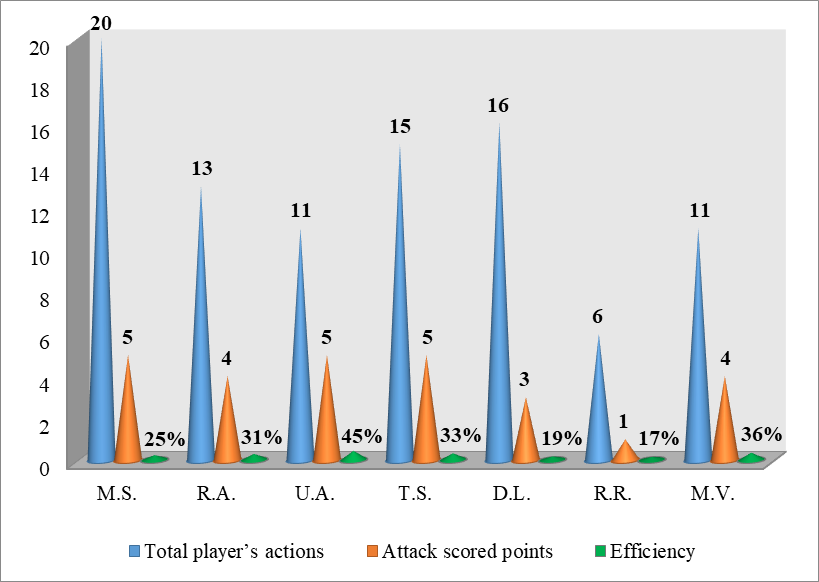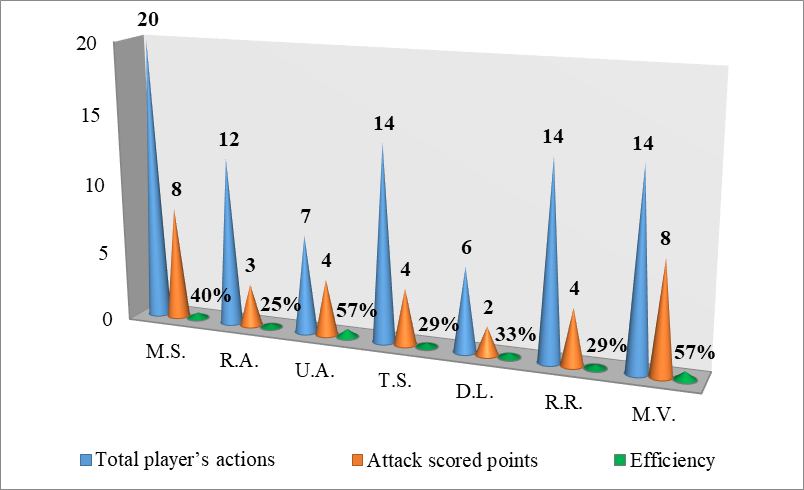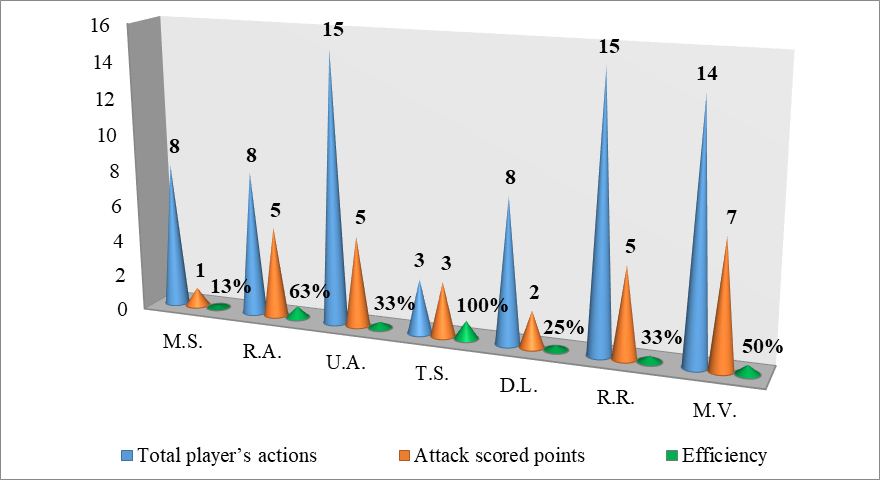Abstract
Problem: Achieving top performance nowadays is no longer possible without a large volume of multi- and interdisciplinary data and the technology that enables high training efficiency. Based on realistic strategies, the aforementioned data and technology would permit the identification of those reference points which offer the safest ways to achieve team objectives within any given context. Purpose: We hypothesize that, by studying the data collected and analyzed by the Data Volley software, and by applying that to training and competitive play, the efficiency of the volleyball techniques of Romanian players will increase and lead to the establishing of a national attack hit model. Premise Study: The following study is noteworthy and innovative in that it analyses a tool little used by junior volleyball teams in Romania, the Data Volley software. Research methods: The following methods were used: scientific research, statistical analysis, observation, case study and comparative analysis. Discussion and conclusions: The national team of the European U18 women's volleyball championship was at the same level as the other participating teams, using the Data Volley program. Through this tool, it was possible to track the evolution of each player in the court, especially the spikers. The information collected by Data Volley, regardless of the fact that both the attack hit efficiency and number of points scored increased, confirms the hypothesis according to which a national women’s junior team attack hit model can in fact be established.
Keywords: Efficiencymodelvolleyballjuniorsattack
Introduction
Today, in order to be able to cope successfully with the great international confrontations, the value of the teams must be based on the game model and the players specializing in the game as a guideline in achieving superior results. For this, knowing the characteristics and trends of the development of the volleyball game in the world is the permanent task of those who work at the level of sports performance (Castro, Souza, & Mesquita, 2011).
Viewed in the context of the volleyball player's training process, modeling is accepted as a principle that orders the programming of the entire content of the training in relation to the established patterns. These models have to recreate all the defining aspects of the game. In order to meet the requirements of the volleyball, it is necessary to systematize the technical-tactical elements of the specialized players on the positions, the somatic and motoric profiles (Balaiş & Păcuraru 1997, p. 92).
The volleyball world performances rise to a very high level lately. To rich the same level we need to change and adapt strategies in specific methodology of player’s training (Bril & Kleshev, 1988). For these reasons we need technological development and endowment.
Modeling has a direct link to systems study, which ensures through feed-back the permanent resizing of the original model. For this, it is necessary to determine the structure of the sporting activity and the volleyball game (Pascu, 2008, p 83).
This study is a volleyball field research and its purpose is to determine which volleyball actions are more efficient for sport performance.
DATA VOLLEY transforms all the actions performed during a match into highly specific codes that describe, in detail, each player hit, in order to carry out detailed analysis for every technical and tactical aspect of the game.
Problem Statement
This study is a volleyball field research and its purpose is to determine which volleyball actions are more efficient for sport performance. The following study is noteworthy and innovative in that it analyses a tool little used by junior volleyball teams in Romania, the Data Volley software, for juniors which objectivies actions of attack
Research Questions
Suppose that, following the data stored and processed by the Data Volley program, and applying them both in preparation and in competition, we can see the evolution of the efficiency of the gaming actions of the players of Romania, which lead to the establishment of an attack model, national level, specific to U17
Purpose of the Study
The purpose of this paper is to present statistically the evolution of the effectiveness of the attacking games of the Romanian team at the European U17 Women's Volleyball Championship, which will lead to the establishment of an attack model at national level
Research Methods
The main goals are:
Granting of the evaluation was done using the scale developed by the FIVB and presented in „Manual for FIVB Statistical Match Record (SMR)”, 1992. Their scaling on 5 levels for attack, as follows:
0 = wrong (-);
1 = keeping the ball in play to limit error (-0);
2 = continuation phase with limited tactical actions (0);
3 = continuation optimal conditions for of phase (+0);
4 = won (+).
Findings
The final round of the European U17 European Championship took place in Sofia, Armeec, Bulgaria, with the following batch of players: (Table
The Table

C. A. was the most efficient Romanian player (45% of 11 attack hit’s attempts) comparing with R. R.’s 17% efficiency (6 attack hit attempts) (figure
Among all players M. S. performed the highest attack hit number of attempts (20) but with only 25% efficiency.
M. S., U. A. and T. S. won 5 points each. They were middle blocker and outside spikers. On the other hand R. R. won only 1 point.

C. A. and M. V. were the most efficient players (57%). U. A. scored 4 points of a total 7 attempts and M. V. 8 of 14 attempts (table

C.A. efficiency was 100% (3 attack hit attempts and 3 won points) compared with that achieved by M.S., 13% (8 attempts and only one point scored). (table
The highest attempt numbers were realized by R.A. and D.L. (15 each) but only 5 won points each. Efficiency was 33%. Even if her efficiency was 100% U.A. realized the lower number of attack hits, 3 (table
Romania's most efficient shooter was C.A. with a percentage of 193 points, the best markers of competition where Romania was ranked 5th.
Zetou et al. (2007) explain how the statistical evaluation of a team's skill performance helped considerably with the development of the game of volley-ball.
The statistic data scouting through the Data Volley 2007 Media Software allows you to quickly transform what you see (the general skills performed by the players) into a standard code that is then analyzed by the computer.
Basically, the statistic scouting represents a structured model for describing the game in order to become a valid and significant support when making team and game decisions.
The possibility to analyze the match in real time is what we define the finishing touch to Data Volley! You can call a time-out and replay the serve directions of the other team to your team or you can focus on the attack directions in a specific rotation (USA Volleyball Organization, 2009, p.72).
This kind of analysis, that can only be performed if the starting zones of the attacks or attack combinations have been scouted, allows you to view in detail, the game distribution of the setter, point by point. If you choose to analyses an attack after reception, an effect value will be displayed for the reception that preceded the attack (Florence, Fellingham, Vehrs, & Mortensen, 2008)
The main advantages of using a model for the description are: abstraction, summary, low price and rapidity.
These features lead to the primal objective of the statistic data scouting: objectiveness.
Conclusion
In the final tournament of the European U17 Women's Volleyball Championship, Romania scored a total of 265 attacks, 198 points and 95 points in the attack. It can be seen the downward trend in the total number of actions in the attack (94 in the first match, 87 in the second and 84 in the last match) and an upward evolution of the points scored in the attack (28 points in attack in the first match, 33 in the second and 34 in the third). It can also be noted that Romania's efficiency has increased from the first match to the last (in the first match = 30%, the second = 38%, the last = 40%), but instead the total score decreased (the first match = 68, the second = 65 and third = 56).
The current level of volleyball is appreciated at the performance level using statistical and mathematical methods of calculating the effectiveness of technical and tactical gaming and training actions (Eloi, Laborie, & Schmit, 1998).
The use of evaluation programs is necessary as it gives the possibility to obtain information about their own team and the adverse team.
Data Volley is a statistical volleyball software that helps in researching and analyzing situations during the game. It can change the real-time game strategy according to the suggestions made by the coach.
The Romanian National at the U17 Women's Volleyball Championship was at the same level as the other participating teams, using the Data Volley program. On the basis of this program, it was possible to observe the evolution of each player in the Romanian team that was in the field, especially the players.
In conclusion, it follows that the action taken during this competition by the shooter shows a progress in the efficiency of the attack actions (from the first match = 30% to the last = 40%).
Based on Data Volley data, even if attack efficiency and attack points increased, the hypothesis is confirmed that we can establish the national gaming model in attack at junta U17.
Acknowledgments
Both authors contributed equally to the work
References
- Balaiş, F. & Păcuraru, Al . (1997). - Volei de la selecţie la performanţă, [Volleyball from selection to performance], Galaţi: Editura Academica.
- Bril, M. S., & Kleshev, U. N. (1988). Modeling characteristics usage of top skills volleyball players during sports schools selection. М.: IFK, 1988, 123.
- Castro, J., Souza, A., Mesquita, I. (2011). - Attack efficacy in volleyball: elite male teams. Perceptual and Motor Skills, 113(2), 395–408.
- Eloi, S., Laborie, P., Schmit, J.M. (1998). - L’observation en volley-ball – Analyse du jeu et statistiques, Paris, Fédération Française de Volley-Ball.
- F.I.V.B. (1992). Book for F.I.V.B. Statistical Match Record (SMR).
- Florence, L. W., Fellingham, G. W., Vehrs, P. R., & Mortensen, N. P. (2008). Skill evaluation in women's volleyball. Journal of Quantitative Analysis in Sports, 4(2).
- Landau, S., & Everitt, B. (2004). A handbook of statistical analysis using SPSS. London: Chapman & Hall/Crc.
- Pascu, D., (2008). Optimizarea modelării și obiectivizarea eficienței în volei, [Optimizing Modeling and Efficiency Efficiency in Volleyball], Craiova: Editura Universitaria.
- USA Volleyball (Organization), (2009). Volleyball systems and strategies, Human Kinetics Publishing House.
- Zetou, E., Moustakidis, A., Tsigilis, N., & Komninakidou, A. (2007). Does Efectiveness of Skill in Complex I Predict Win in Men's Olympic Volleyball Games? Journal of Quantitative Analysis in Sports, 3, article 3.
Copyright information

This work is licensed under a Creative Commons Attribution-NonCommercial-NoDerivatives 4.0 International License.
About this article
Publication Date
15 August 2019
Article Doi
eBook ISBN
978-1-80296-066-2
Publisher
Future Academy
Volume
67
Print ISBN (optional)
-
Edition Number
1st Edition
Pages
1-2235
Subjects
Educational strategies,teacher education, educational policy, organization of education, management of education, teacher training
Cite this article as:
Cojocaru*, A., & Cojocaru, M. (2019). Determining The Game Model In Atac, In Junior Girls Volley (U18). In E. Soare, & C. Langa (Eds.), Education Facing Contemporary World Issues, vol 67. European Proceedings of Social and Behavioural Sciences (pp. 381-388). Future Academy. https://doi.org/10.15405/epsbs.2019.08.03.45
